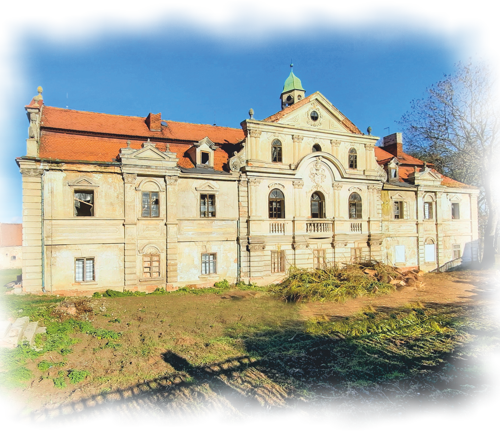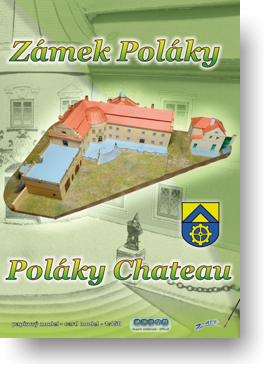

ABOUT POLÁKY CHATEAU
Poláky village is located in the North-West of the Czech Republic in Kadaň district. The area around Poláky has been one of the oldest inhabited places since the prehistoric times, specifically since the Corded Ware Culture. A large burial ground from 7th to 5th Century B.C. was found in the area around Poláky. In the Slavic times, this settlement belonged to the “Lucko” principality, which was divided into five counties. Poláky belonged to the Kadaň County.
In 12th Century, Poláky area belonged to the Cistercian monastery in Waldsassen (in today´s Bavaria). There was a farmyard established by the Cistercians in the place of today´s chateau. The farm was well kept, there were stables, granaries and an agricultural tools manufacture.
The first written document about Poláky village comes from 1318 – the village belonged to Vlk and Bavor of Poláky clan. In 1620´s it was owned by the Mašťov of Kolovrats, who built a fortress in the place of today´s chateau. The first document about the fortress comes from 1546 when the Mašťov lords sold the fortress along with Poláky village and two nearby villages to Jan Žďárský of Žďár. The following owners switched often. During the Thirty Years´ War, the fortress was damaged significantly and it remained in debris for another century.
In 1745 – 1815, Poláky was owned by the counts of Pergen. They had the remains of the old fortress demolished and built a late Baroque chateau on its grounds. They used the old basements and remains for building the chateau. The new chateau, standing in the corner of a former farmyard, had two floors and two wings and was designed by Vavřinec Roth, a builder coming from nearby Žatec.
In 1815, the manor was bought by the Windischgrätz family and in 1868, by the Lobkowitz family. Josef, the duke of Lobkowitz, owned the chateau, four farmyards and 428 hectares of lands. The Lobkowitz family owned Poláky until early 1920´s, when it was confiscated by the Czechoslovakia State. In 1924, it was bought by Rudolf and Anna Hrbáček from Hradčovice. They altered the chateau in the Neo-Baroque style, which gave it its recent form. They also had a villa for the director built near the chateau. The large Neo-Baroque reconstruction was made by Antonín Ripl, a builder coming from Libědice. The Poláky domain owned farms Poláky, Hořenice, Dolany and Chotěnice and also 705 hectares of lands including 450 hectares of fields and 255 hectares of forests. The last owner before another confiscation by the state was Adolf Kollmann.
In 1948, Czechoslovakia State confiscated the chateau and it was administrated by the local “state farm.” There were offices, apartments for the employees and archive. This was good for the chateau because the exteriors and interiors were preserved fairly well. However, after the revolution in 1989, it was returned by the ancestors of the last owners in 1990. They offered it for sale and in the following years, nobody took care of the buildings and garden. The whole grounds were abandoned for years, it was looted, destroyed and left to its own fate. In 2020, the new owner became Miloš Dempír, who soon started to restore and renovate the chateau and its surrounding area. This model was created thanks to great co-operation with Mr Dempír.
The Poláky Chateau consists of a two-storey building with two wings built at right angles. The facades on the front wall of the building and on the cylindrical avant-corps (risalto) are Neo-Baroque, the other facades facing the yards are in the original Baroque style. Baroque and Neo-Baroque elements mix also in the roofs decoration. There is a Hrbáček family coat-of-arms in a richly decorated frame on the semicircular arch on the main ledge. Their coat-of arms is also displayed above the main entrance to the chateau. Inside the cylindrical avant-corps, there is the entrance hall with a three-wing staircase and a balcony standing on four columns with decorated heads and arcades. The ground floors are crowned with stucco and vault-lunette cross-arched ceilings. The first floor has flat ceilings, with remains of stucco decorating in almost every room. The floors are fairly well preserved – tiled on the ground floor and laid with parquets on the first floor. There are remains of the original Renaissance fortress in the basements.
 Poláky Chateau 01 |
 Poláky Chateau 02 |
 Poláky Chateau 03 |
 Poláky Chateau 04 |
 Poláky Chateau 05 |
 Poláky Chateau 06 |
 Poláky Chateau 07 |
 Poláky Chateau 08 |
 Poláky Chateau 09 |
You can order in our e-shop.
Back


